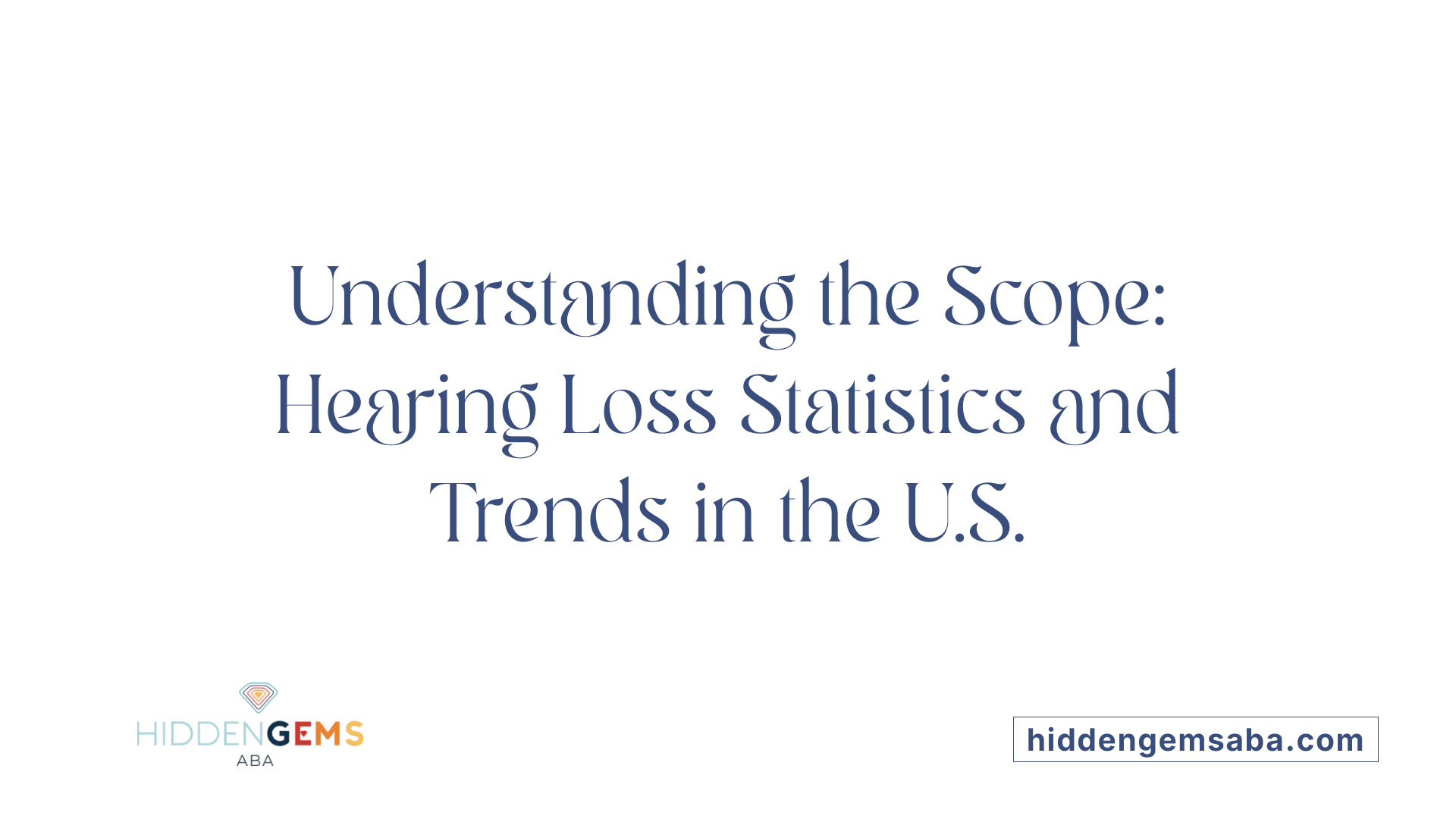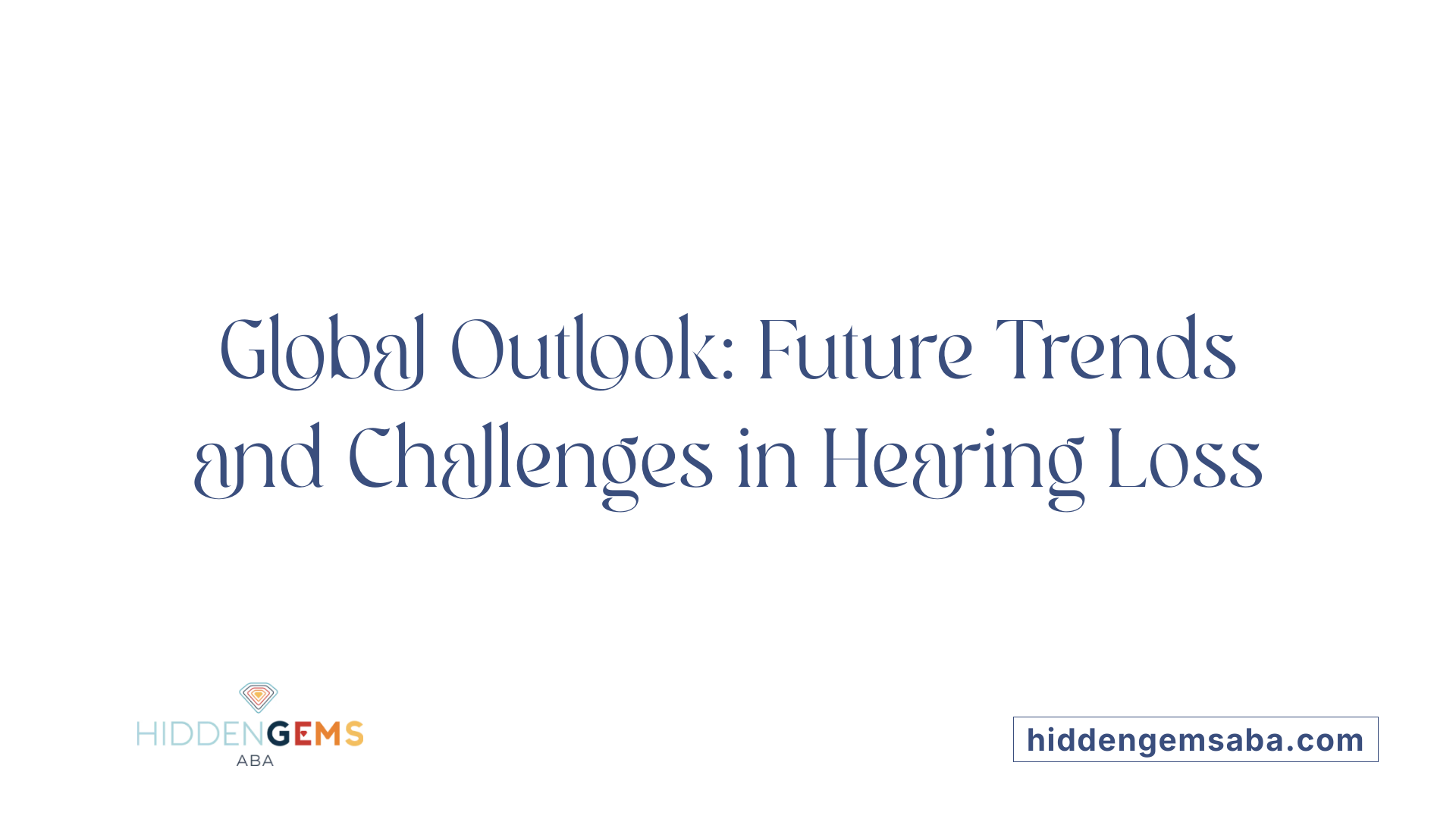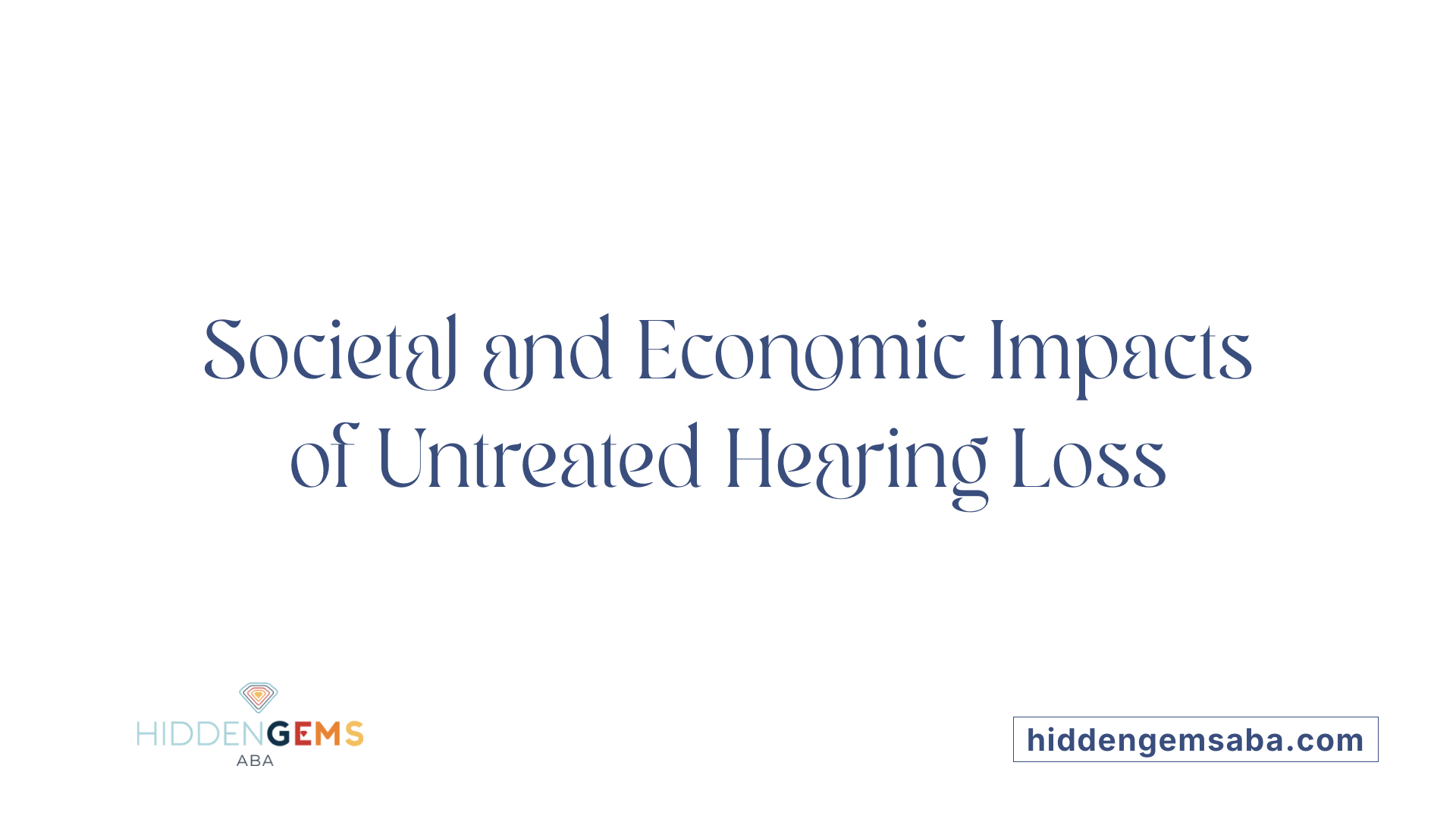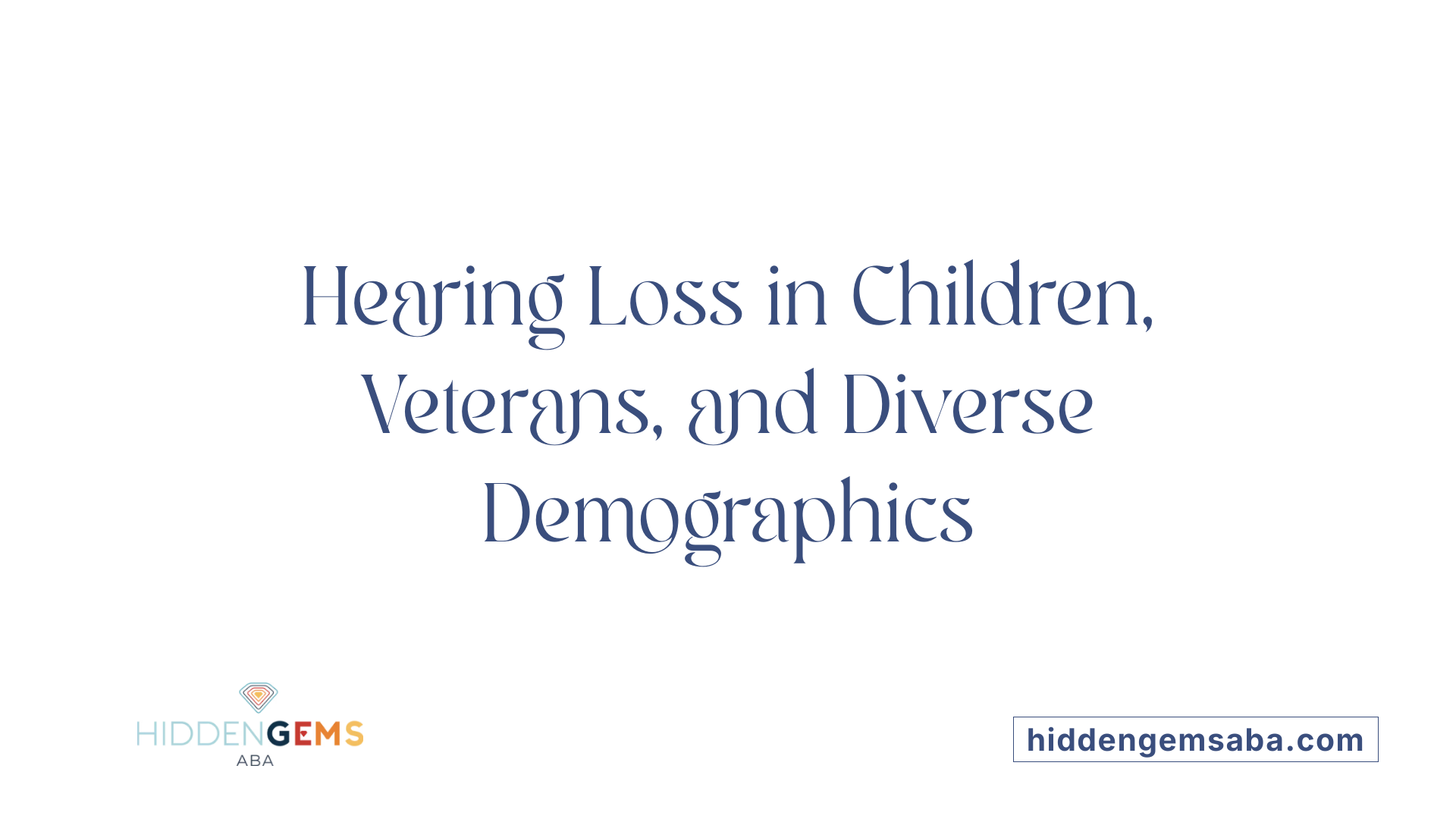Understanding the Scope and Impact of Hearing Loss
Hearing loss remains one of the most common yet often overlooked health conditions worldwide. Affecting millions across all ages, its prevalence is projected to rise significantly in the coming decades. This article explores current statistics, causes, demographics, and global trends related to hearing impairment, emphasizing the importance of early detection, preventive measures, and accessible treatment options.
Prevalence of Hearing Loss in the United States

What are some recent statistics on hearing loss?
Recent data paint a concerning picture of hearing health in the U.S. and worldwide. Over 1.5 billion people globally are affected by hearing loss, with 430 million experiencing disabling levels that hinder daily activities. Looking ahead, projections suggest that by 2050, nearly 2.5 billion individuals will have some degree of hearing impairment, and over 700 million will require rehabilitation for severe cases.
In the United States, approximately 15% of adults, about 37.5 million people, report some trouble with hearing. Despite the high number of individuals who could benefit from hearing aids—estimated at around 28.8 million—only a small percentage currently access this technology. The gap between potential and actual use highlights barriers such as cost, stigma, and lack of awareness.
Age heavily influences hearing loss prevalence. More than 25% of people aged over 60 are affected, with prevalence rising steeply among older seniors. Nearly all individuals over 90 experience some form of hearing difficulty. Globally, most cases are deemed preventable through protective measures and early intervention, emphasizing the need for better public health strategies.
What is the odds of losing hearing in the general population?
The likelihood of experiencing hearing loss is significant across the population. About 13% of Americans aged 12 and older—roughly 30 million people—have confirmed hearing impairment in both ears based on standard examinations.
Among adults, the prevalence is about 15%, with the condition being more common as age advances. Men are almost twice as likely as women to suffer from hearing loss, reflecting differences in exposure to noise and occupational hazards. Age remains the most critical predictor, with the rates climbing sharply in the over-60 demographic.
Occupational noise exposure is a notable risk factor, affecting roughly 20-30 million workers annually. However, about half of those exposed do not wear hearing protection, further increasing their risk.
The chance of losing hearing underscores the importance of preventive measures, awareness, and access to treatment options like hearing aids and cochlear implants. Although the statistical scope is broad, targeted interventions could significantly reduce the burden.
Overview of Adult Hearing Loss Statistics
| Age Group | Prevalence of Hearing Loss | Percentage or Number | Additional Details |
|---|---|---|---|
| Overall in U.S. | Adults with hearing trouble | 15% (37.5 million) | Based on reporting by adult Americans |
| Ages 20-69 | Slight decrease since 1999-2004 | From 16% to 14% | Indicating some improvement possibly due to better awareness or technology |
| Ages 45-54 | Disabling hearing loss | 5% | Exposes early onset of age-related issues |
| Ages 55-64 | Disabling hearing loss | 10% | Increasing trend with age |
| Ages 65-74 | Disabling hearing loss | 22% | Significant rise, affecting everyday communication |
| 75 and older | Disabling hearing loss | 55% | Majority experiencing some level of hearing impairment |
| Adults over 70 | Hearing aid usage | Less than 30% | Many could benefit but do not use aids due to various barriers |
| Adults over 90 | Hearing loss prevalence | 96% | Nearly universal among the oldest age group |
Impact and Disparities
Hearing loss in the U.S. affects a diverse population with disparities in usage of assistive devices. Fewer than 30% of those who could benefit from hearing aids are actually using them, especially among minorities and lower-income groups. The economic impact is notable, with annual losses from reduced employment and productivity estimated in billions.
Internationally, the situation exacerbates in low- and middle-income countries, where most affected individuals live, yet access to hearing aids remains limited. Efforts are ongoing to improve screening, early intervention, and access to affordable hearing care worldwide.
Future Outlook
If current trends continue, the number of people with hearing loss will continue to rise, mainly driven by aging populations and environmental factors like noise pollution. Public health initiatives focusing on prevention, early detection, and treatment are essential to manage this growing global challenge.
| Global Perspective | Global Population with Hearing Loss | Projected Cases for 2050 | Notes on Disparities |
|---|---|---|---|
| Worldwide | Over 1.5 billion affected, 430 million with disabling hearing loss | 2.5 billion with some hearing loss; 700 million with disabling loss | Coverage gap, especially in low-income areas |
| Children | 34 million globally with deafness or hearing loss, 60% preventable | Clear rising trend | Early detection critical for intervention |
This overview highlights the significant burden of hearing loss in the United States, underscoring the importance of ongoing preventive, diagnostic, and treatment efforts to improve outcomes for millions affected.
Global Hearing Loss Trends and Future Projections

Why is hearing loss on the rise globally?
Hearing loss is increasing worldwide due to multiple interconnected factors. One primary driver is the aging global population. As life expectancy improves, a larger proportion of people live into older age brackets where hearing impairment is more prevalent, with nearly 80% of those over 70 experiencing hearing issues.
However, aging is not the sole reason. Increased exposure to loud noise, especially in workplaces, recreational activities, and through personal listening devices, significantly contributes to noise-induced hearing loss among younger generations. Many young adults and teenagers are at risk because of unsafe listening practices, with about 1 in 4 at potential risk of permanent exposure to unsafe sounds.
Environmental risks, including infections during pregnancy, head injuries, smoking, and certain medical conditions, also contribute to the rising prevalence. Improvements in diagnosis and awareness have led to more cases being detected across all age groups, further adding to the numbers.
Lifestyle habits such as frequent exposure to loud environments and insufficient use of hearing protection are key contributors. Despite the availability of preventive measures like hearing protection and early screening, many remain unprotected or unaware of their risk, fueling the trend of increasing global hearing impairment.
What are the future projections and global burden related to hearing loss?
Forecasts indicate that by 2050, nearly 2.5 billion people worldwide will experience some degree of hearing loss. Among these, over 700 million individuals are expected to suffer from disabling hearing impairment, which significantly impacts quality of life and social participation.
The World Health Organization (WHO) estimates that more than 5% of the global population—approximately 430 million people—require hearing rehabilitation services, including around 34 million children. The burden will intensify as population growth and aging demographics continue unchecked.
Most affected populations reside in low- and middle-income countries, where access to hearing health services, including screening, hearing aids, and rehabilitation, remains limited. This disparity means that a significant portion of those affected will not receive adequate care.
Environmental factors, limited awareness, and insufficient health infrastructure contribute to the projected rise. Without targeted interventions such as noise control policies, early screening, and accessible treatment options, the global burden of hearing loss will escalate further.
Disparities between high and low income countries
While hearing loss affects all regions of the world, the majority of cases—over 80%—are concentrated in low- and middle-income countries. These nations face challenges like limited screening programs, scarce hearing aids, and fewer trained specialists.
Production and distribution of hearing aids are also heavily skewed. Currently, global hearing aid production covers only about 3% of the need in resource-limited settings. Consequently, many individuals with hearing impairment in these regions do not receive essential corrective care.
Drivers of increasing prevalence
The main factors driving the rise in hearing loss include:
- Aging populations: As global mortality rates decline, more individuals reach older ages when hearing loss becomes common.
- Noise exposure: The proliferation of loud recreational and occupational environments, especially in urban areas, increases noise-induced hearing loss.
- Lifestyle influences: Use of personal audio devices at high volumes and participation in noisy leisure activities contribute significantly.
- Environmental and medical factors: Infections, head trauma, and lifestyle-related health issues like diabetes exacerbate risk.
Efforts focusing on prevention, such as promoting safe listening, early detection, and improved health policies, are vital to controlling this upward trend.
To summarize, the worldwide prevalence of hearing impairment is on a steady climb, influenced largely by demographic shifts and lifestyle choices. Without robust intervention strategies, the global burden will continue to increase, highlighting the urgent need for international health initiatives to address disparities and promote hearing health.
Causes, Risk Factors, and Demographics of Hearing Loss

What is the primary cause of acquired hearing loss?
The leading cause of acquired hearing loss is exposure to loud noise, which impacts over a quarter of affected individuals. This includes noise from workplaces, recreational activities, and loud music. In addition to noise, other contributors include injuries, infections such as meningitis or mumps, use of ototoxic medications, and degenerative processes associated with aging, notably presbycusis.
Most acquired hearing loss stems from damage to the inner ear's delicate hair cells or the auditory nerve, resulting in sensorineural deafness that is usually permanent. Conductive hearing loss can also occur, caused by blockages like earwax, middle ear infections, or damage to ossicles.
Early detection and avoiding exposure to damaging sounds are crucial in managing or preventing this form of hearing loss. Protective measures such as hearing protection in noisy environments can significantly reduce risk.
Why is hearing loss more prevalent among older adults?
Hearing loss increases markedly with age due to natural aging processes termed presbycusis. This condition involves progressive degeneration of cochlear structures, especially hair cells, and can include damage to the auditory nerve.
As people age, they experience cumulative environmental insults—such as prolonged noise exposure and medical conditions—that worsen hearing decline. Data shows that nearly 80% of those over 70 report some hearing impairment.
Older adults often develop comorbid health issues like cardiovascular disease and diabetes, which further compromise auditory health. These factors contribute to the high prevalence of hearing impairment in the elderly population.
What role do genetics and environment play in hearing loss?
Genetics play a significant role, especially in congenital cases. An estimated 50-60% of childhood hearing loss cases are hereditary, involving gene mutations that affect ear development or function.
Environmental factors also heavily influence hearing health. Infections during pregnancy, such as cytomegalovirus, lead to congenital deafness. Exposure to loud noise, head trauma, and ototoxic drugs are preventable causes that contribute to acquired hearing loss.
Nearly 30% of cases are linked to these preventable causes, underscoring the importance of early intervention, vaccination, protective measures, and lifestyle adjustments.
The interaction between genetics and environmental factors determines an individual's risk profile. Early identification and managing environmental risks can help reduce the overall burden of hearing impairment.
Impacts of Hearing Loss on Society and Economy

What challenges do persons with hearing impairment face?
Persons with hearing impairment encounter numerous obstacles that significantly affect their everyday lives. Communication difficulties are at the forefront, often leading to social isolation and exclusion. These individuals may struggle to participate fully in social, educational, and workplace environments, which can hinder personal and professional growth.
Societal prejudices and misconceptions further exacerbate their struggles. Many face societal biases that impede access to services and support systems. Structural barriers such as insufficiently accessible public spaces, architecture not adapted for hearing impairments, and the shortage of assistive technologies like hearing aids and cochlear implants also limit their inclusion. Economic disparities play a major role; higher costs and complex healthcare procedures often restrict access to advanced hearing devices.
Many persons with hearing difficulties experience higher rates of poverty, unemployment, and lower educational achievements compared to those without hearing challenges. Recognizing these hurdles underscores the importance of creating policies that promote awareness, accessibility, and societal support to enhance the quality of life for this population.
What are the societal costs and health implications associated with untreated hearing loss?
Untreated hearing loss carries substantial consequences for both society and individual health. Socially, it can lead to profound isolation, depression, and cognitive decline. Evidence shows that even mild hearing impairment nearly doubles the risk of developing dementia, while severe hearing loss can increase this risk fivefold. This demonstrates a direct link between untreated hearing difficulties and serious mental health conditions.
Economically, untreated hearing impairment reduces productivity and lowers earnings. On average, affected individuals earn approximately £2,000 less annually, resulting in significant financial losses on a personal and national level. Societal costs also include higher healthcare expenses tied to mental health and cognitive disorders, along with increased demand for social and educational support services.
The broader public health impact is clear: widespread untreated hearing loss adds to the burden of disease and disability. It underscores the importance of early screening, accessible hearing health services, and policies aimed at prompt intervention to prevent associated health declines.
What actions are necessary to address hearing loss at the societal level?
Tackling hearing loss on a society-wide scale involves a multi-pronged approach centered on prevention, early detection, and treatment accessibility. Universal newborn hearing screening programs, such as the 1-3-6 rule (screen by 1 month, diagnose by 3 months, intervene by 6 months), have proven effective in identifying hearing issues early, improving language development and social integration for children.
Preventive strategies include promoting awareness about noise hazards and encouraging the use of hearing protection in occupational and recreational settings. Regulating noise levels can substantially reduce risk, particularly among young and middle-aged adults.
Expanding access to affordable hearing aids and cochlear implants is crucial, especially in low-income and developing regions where production covers just a small fraction of global need. Policymakers must support initiatives that make these technologies more accessible and reduce associated costs.
Furthermore, fostering inclusive environments through accessible communication technologies and reducing stigma associated with hearing loss are vital steps. Enhancing research funding and public education campaigns can further reduce barriers, encourage early help-seeking, and promote societal integration.
Collectively, these measures can significantly diminish the societal and economic burdens of hearing loss, leading to healthier, more inclusive communities.
| Aspect | Current Status | Recommendations | Impact |
|---|---|---|---|
| Detection in newborns | Over 98% screened in the US, early identification of 6,000 cases | Maintain and expand universal screening programs | Early intervention leads to better developmental outcomes |
| Hearing aid accessibility | Less than 30% of adults over 70 use aids despite need | Improve affordability and insurance coverage | Increased aid use reduces social and cognitive issues |
| Public awareness | Limited awareness about noise dangers and prevention | Launch educational campaigns and enforce regulations | Decreased incidence of noise-induced hearing loss |
| Treatment affordability | Limited access in low-income regions | Enhance global production and subsidy programs | Greater access reduces untreated impairment and related health risks |
| Policy and advocacy | Inconsistent policies worldwide | Develop comprehensive policies and support research | Better societal support and resource allocation |
Understanding and acting on these factors is crucial for reducing the societal and economic impacts of hearing loss, ensuring healthier individuals, and fostering inclusive communities.
Special Populations and Demographics

What is the prevalence of hearing loss among children and infants?
Hearing loss can significantly impact early childhood development, including speech and language acquisition. In the United States, approximately 1 in 500 infants are born with or develop hearing loss during early childhood. Each year, neonatal screening programs identify around 6,000 infants with permanent hearing impairments. Globally, the burden is substantial, with about 34 million children affected by deafness or hearing loss. Many of these cases are preventable, especially when associated with congenital infections like cytomegalovirus. Genetics play a major role, contributing to 50-60% of childhood hearing loss cases. Early detection through universal screening and prompt intervention with hearing aids or cochlear implants are essential, as they foster better speech, social, and cognitive outcomes for affected children.
How does hearing loss affect veterans and workers exposed to noise?
Veterans and workers in noisy environments are among the most affected groups when it comes to hearing loss. In the United States, hearing issues are the most common service-related disability, with approximately 3.6 million veterans receiving benefits for hearing-related conditions. Occupational exposure to hazardous noise affects about 30 million U.S. workers, such as those in manufacturing, construction, and military settings.
Despite the widespread availability of hearing protection, a significant proportion—about 53%—of noise-exposed workers fail to use protective devices regularly. This gap contributes to ongoing hearing deterioration and increased tinnitus prevalence, with around 11% of adults experiencing ringing or buzzing in the ears. The health and economic implications are notable, as untreated hearing loss can lead to social isolation, reduced employment opportunities, and higher healthcare costs.
Preventive measures, including workplace safety regulations and education on hearing protection, are critical to reducing risks. Promoting awareness among military personnel and industrial workers can help mitigate long-term hearing damage in these vulnerable populations.
What disparities exist in hearing loss prevalence and access to treatment among different demographic groups?
Hearing loss does not impact all populations equally, with notable disparities influenced by race, ethnicity, and socioeconomic status. In the United States, only about 29.2% of older adults with hearing loss use hearing aids, and usage rates are even lower among Black and Hispanic communities, as well as among individuals with lower incomes. These disparities are rooted in several challenges, including affordability, lack of awareness, and limited access to audiological services.
Ethnic and economic barriers often delay diagnosis and treatment, exacerbating social disadvantages and health inequalities. For example, minorities may experience longer wait times and reduced access to high-quality care, which influences hearing aid adoption and hearing health outcomes.
Addressing these gaps involves implementing targeted public health policies, subsidizing assistive technology, and providing culturally sensitive healthcare services. Increasing community outreach and education can improve awareness and encourage earlier intervention, ensuring all populations receive equitable hearing healthcare.
| Population Group | Prevalence & Impact | Access & Disparities | Proposed Solutions |
|---|---|---|---|
| Children & Infants | 1 in 500 born with hearing loss; 34 million worldwide | Early screening critical; genetic and preventable causes | Universal newborn screening; early intervention programs |
| Veterans & Workers | 3.6 million veterans; 30 million noise-exposed workers | Low hearing protection use; high prevalence of tinnitus | Improve workplace safety; promote hearing protection |
| Ethnic & Socioeconomic Groups | Lower hearing aid use among minorities and low-income populations | Delays in diagnosis; lower treatment access | Culturally tailored programs; affordability initiatives |
Hearing loss is a widespread health issue with varied impacts across different populations. Focusing on early detection, preventative measures, and equitable access to care remains vital to addressing the disparities and ensuring better health outcomes for vulnerable groups.
Summarizing the Urgency of Addressing Hearing Loss
As the statistics reveal, hearing loss is a pervasive condition affecting millions worldwide, with a growing trend driven by demographic and environmental factors. The substantial individual, societal, and economic impacts underline the need for proactive measures such as early screening, public awareness campaigns, and accessible treatment options. Addressing disparities in care and promoting preventive strategies can significantly reduce the burden in both developed and developing regions. Prioritizing hearing health is essential for improving quality of life, cognitive health, and social integration globally. The emerging data urges governments, healthcare providers, and communities to work collaboratively to combat this silent epidemic and preserve hearing health across all ages.
References
- Quick Statistics About Hearing, Balance, & Dizziness - nidcd.nih.
- Deafness and hearing loss - World Health Organization (WHO)
- Hearing Loss by the Numbers
- Deafness and hearing loss - World Health Organization (WHO)
- Updated hearing loss and hearing aid statistics - Healthy Hearing
- Research and Tracking | Hearing Loss in Children - CDC
- Hearing Loss Facts | Center for Hearing and Communication
- Hearing Loss & Tinnitus Statistics - Hearing Health Foundation
- Prevalence of Hearing Loss and Hearing Aid Use Among US ...






